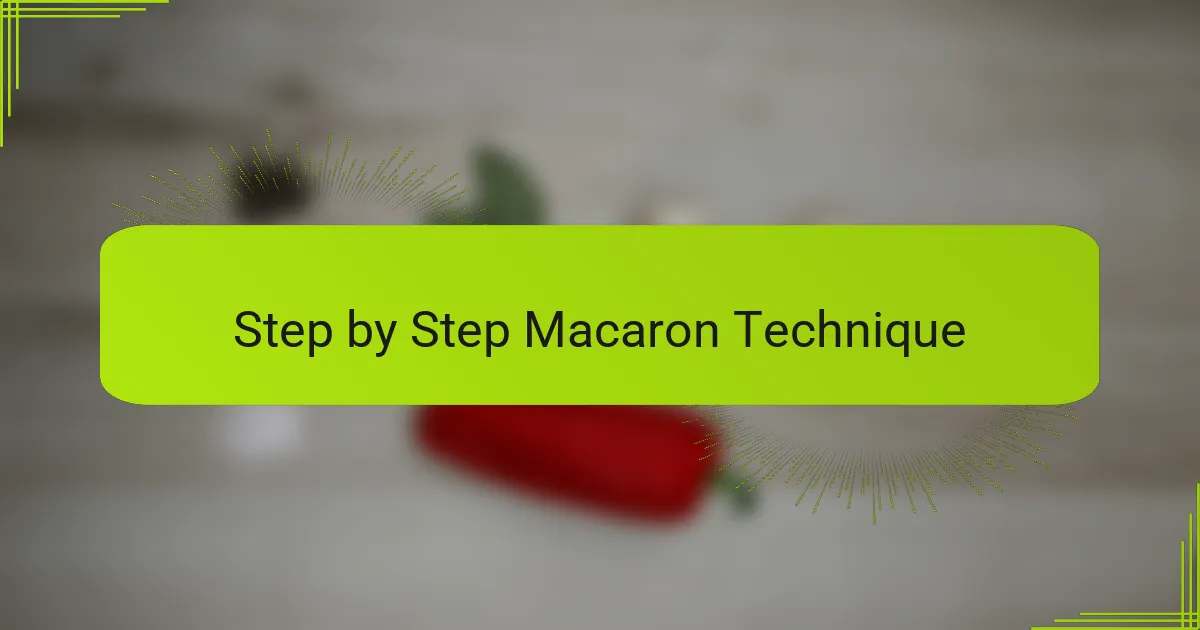Key takeaways
- Macarons combine precision and creativity, making them a rewarding baking challenge.
- Key ingredients include almond flour, egg whites, and a balance of sugars, which contribute to their unique texture and flavor.
- Technique, such as proper macaronage and resting time, is crucial for achieving perfect shells with feet.
- Mentorship, like learning from experts such as Pierre Hermé, can transform the baking experience into a more intuitive and enjoyable journey.

Introduction to Macarons
Macarons are those delicate, colorful French cookies that seem almost too beautiful to eat. I remember the first time I tasted one—how the crisp shell gave way to a soft, chewy center filled with luscious cream. Have you ever wondered what makes these treats so irresistibly special?
Their allure isn’t just in their taste but also in the challenge they present. Making macarons requires precision and patience, which to me makes the reward even sweeter. It’s like a delicious puzzle that calls for both art and science.
What’s fascinating is how these tiny confections have become a symbol of elegance and creativity in the dessert world. Each flavor and color combination tells its own story, inviting you to explore endless possibilities with every bite.

Essential Ingredients for Macarons
When I first started making macarons, I quickly learned that the ingredients truly hold the secret to their success. Almond flour is not just any flour—it’s finely ground almonds that give macarons their signature nutty flavor and delicate texture. Have you noticed how essential the almond flavor is to that perfect bite?
Egg whites are another star player. They need to be just right—whipped to the perfect meringue consistency—which brings that glossy shell and lightness we all crave. I’ve spent hours mastering this, realizing that even a slight change in how the egg whites behave can make or break the entire batch.
And then there’s the sugar, both granulated and powdered, which adds sweetness and stability. Pierre Hermé always emphasized to me how balancing the sugars helps achieve that emblematic smooth shell and chewy interior. It’s fascinating how these simple ingredients work in harmony to create something so elegant and complex.

Step by Step Macaron Technique
Getting the technique just right is where the magic happens. When I first tackled the macaronage—the process of folding the almond flour and powdered sugar mixture into the meringue—I underestimated how crucial it is to find that perfect balance. Too much folding, and the batter becomes runny; too little, and it stays stiff. Have you ever tried to gauge consistency by eye? It’s tricky, but with practice, you start to feel it instinctively, just like I did after countless batches.
Piping the batter is another step that demands attention. I learned from Pierre Hermé that keeping a steady hand and consistent pressure creates those perfectly rounded shells. There’s something almost meditative about it, watching the batter gently fall onto the tray, forming little domes that promise a delicious outcome. Do you notice how small gestures like this can transform a baking experience from chore to art?
Finally, the drying phase before baking truly made me appreciate patience. Letting the macarons rest until a thin skin forms on the surface feels like waiting for a secret to reveal itself. Skipping this step once led to cracks, and the disappointment was real. Now, I always remind myself that great macarons aren’t made by rushing—it’s about honoring the process to get that iconic smooth, shiny shell with feet.

Baking Tips from Pierre Hermé
Pierre Hermé once shared with me the importance of temperature control—the oven must be just right, not too hot or too cold. Have you ever opened your oven mid-bake and noticed your macarons lose their perfect rise? I learned that resisting the urge to peek is tough, but it makes all the difference in achieving that delicate structure.
He also stressed the value of weighing ingredients to the gram. I used to eyeball measurements and often ended up with inconsistent results. Pierre’s methodical approach taught me that precision is what turns good macarons into exceptional ones, and honestly, it felt empowering to have such control over the outcome.
Another tip that stuck with me is to experiment with resting times before baking. Pierre explained that the drying phase can vary depending on humidity, and sometimes waiting a bit longer creates stronger shells with better feet. It made me realize how much patience and observation matter—baking macarons isn’t just following a recipe, it’s learning to listen to your environment.

Filling and Flavor Ideas
When it comes to fillings, I’ve found that the possibilities are truly endless—and that’s part of the fun. Pierre Hermé often suggests pairing a classic vanilla bean ganache with unexpected twists, like a hint of yuzu or rosewater, which instantly elevates the flavor. Have you ever thought about how a simple flavor addition can transport your taste buds to an entirely new place?
I personally love experimenting with contrasting textures inside my macarons. For instance, adding a smooth praline paste gives a rich nuttiness, while a tart fruit jam cuts through the sweetness with brightness. Balancing these elements is like composing a little flavor symphony—doesn’t that sound delightful?
Don’t overlook seasonal inspirations, either. In cooler months, a spiced chocolate ganache brings warmth, while in spring, fresh lemon curd or lavender-infused cream offers a light, fragrant surprise. From my experience, letting the filling ideas flow with the seasons keeps the macarons feeling fresh and exciting every time.

Troubleshooting Common Issues
Sometimes, despite all your care, macarons can crack or develop hollow shells. I remember one batch where every shell was cracked—a heartbreaking moment! What helped me was adjusting the oven temperature slightly lower and making sure I didn’t skip the crucial drying phase before baking. It’s amazing how small tweaks can save a batch.
Another tricky issue I’ve faced is macarons that spread too much and lose their signature feet. At first, I thought my batter was too thin, but Pierre Hermé taught me to trust the macaronage technique and not overmix. Finding that balance between a glossy, flowing batter and one that holds its shape is an art—I still check the batter by dropping a bit on the tray to see how it settles before piping.
Finally, sometimes the feet just won’t form, and the shells look flat and sad. I used to get frustrated until I realized humidity plays a big role. Waiting longer for a proper skin to develop before baking can fix this, even if it means more patience. Have you ever been tempted to rush this step? I’ve learned that, in the end, patience really is the secret ingredient.

Personal Macaron Experience with Pierre Hermé
Spending time in the kitchen with Pierre Hermé was truly eye-opening. I recall how his calm focus and attention to detail made me realize that macarons are much more than just a recipe—they’re a delicate craft. Have you ever noticed how watching an expert work can make you appreciate the subtlety of every step? That day, I felt a deep respect for the patience and precision required.
What struck me most was Pierre’s encouragement to trust my senses alongside the technique. He didn’t just hand me instructions; he invited me to feel the batter, listen to the oven, and really connect with the process. I remember feeling both nervous and excited, wondering if I could match his finesse, but his gentle guidance made it feel achievable. Doesn’t that kind of mentorship make learning something new so much richer?
After making macarons with him, I saw every challenge—whether it was folding the batter or getting the perfect bake—as part of a creative journey, not a hurdle. I think that experience changed how I approach baking entirely. Have you ever had a moment where working alongside a master shifted the way you see your craft? For me, that was it with macarons and Pierre Hermé.




